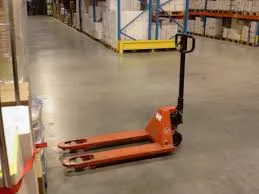


Understanding Hand Pallet Jacks A Versatile Tool for Material Handling
Hand pallet jacks, also known as manual pallet trucks, are indispensable tools in warehouses, distribution centers, and retail environments. These compact devices enable workers to efficiently move heavy loads with ease, making them a popular choice for many businesses. This article explores the significance, functionality, and benefits of hand pallet jacks in modern material handling.
At its core, a hand pallet jack consists of a steel frame, two forks, and a hydraulic lifting mechanism. The forks slide under the pallet, allowing the user to lift and transport goods by simply pumping the handle. The design is remarkably simple yet effective, providing a mechanical advantage that makes it possible to maneuver loads weighing up to several thousand pounds. This simplicity ensures that operators can quickly learn to use the equipment, minimizing training time and increasing productivity.
One of the primary advantages of hand pallet jacks is their versatility. They can navigate narrow aisles and tight spaces where larger machinery would be impractical. This compact design is particularly beneficial in bustling warehouses, where space is often at a premium. Additionally, hand pallet jacks are available in a variety of designs, including those specifically tailored for certain tasks, such as low-profile models for lower pallets or heavy-duty options for more substantial loads.

Another compelling reason for the popularity of hand pallet jacks is their affordability and low maintenance costs. Compared to electric pallet jacks or forklifts, manual pallet jacks are significantly less expensive to purchase and maintain. They do not require batteries or electric charging, which eliminates the need for battery management and reduces operational costs. As a result, businesses, especially small-to-medium enterprises, can invest in multiple units without straining their budgets.
Safety is a critical aspect of material handling, and hand pallet jacks are designed with operator safety in mind. Many models feature safety features such as adjustable forks, ergonomic handles, and safety brakes, which minimize the risk of accidents. Proper usage of hand pallet jacks, combined with appropriate safety training, can significantly reduce workplace injuries related to manual handling.
Moreover, hand pallet jacks contribute to enhanced efficiency in logistics operations. With the ability to quickly move goods around, workers can streamline processes, reduce labor costs, and optimize inventory management. The ease of use encourages employees to adopt a more organized approach to handling materials, thereby improving overall workflow.
In conclusion, hand pallet jacks play a crucial role in the realm of material handling. Their simplicity, versatility, cost-effectiveness, and safety features make them an essential tool for businesses across various industries. As supply chains grow increasingly complex, the importance of efficient and effective material handling solutions continues to rise. Investing in quality hand pallet jacks can enhance operational efficiency and lead to smoother, safer, and more productive work environments.



